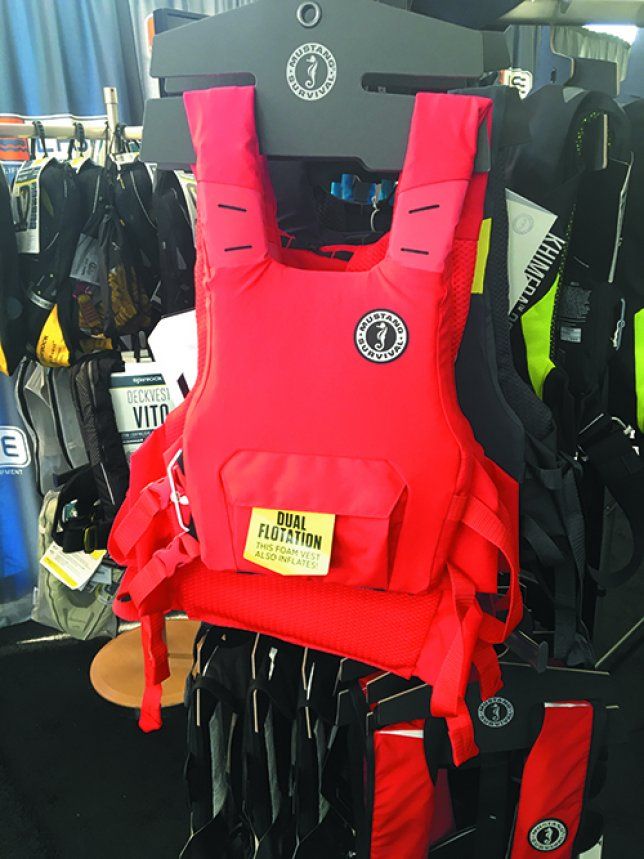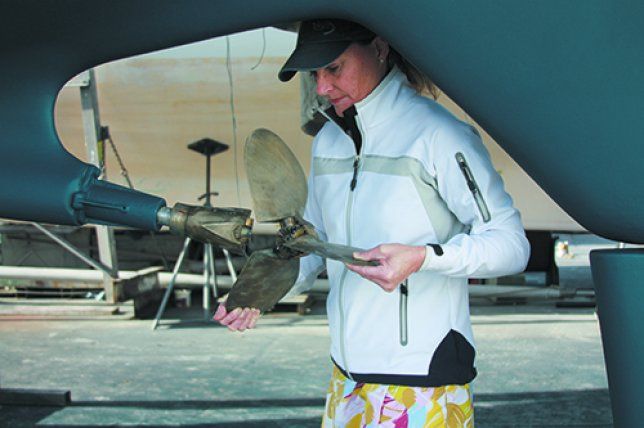Gori Propellor report
Regarding your report on props, (Folding and Feathering Props, February 2018), I installed a Gori propeller on my Beneteau 393 before setting sail from the Great Lakes to the Caribbean for a year. My choice was based on the fact that Gori was the only propeller with an overdrive. This means that in an emergency, I have full power and RPM when needed. It also means in the vast majority of cases, I can use overdrive to load the 56-horsepower Yanmar at lower RPMs, improving efficiency and engine longevity. The results were amazing in forward. I gained a knot on most conditions under sail, and a knot when using the overdrive at the same RPM. The downside was reversing power was impacted quite a bit. I had much less bite in reverse than with the fixed prop that I replaced. I also had more noticeable prop-walk in reverse, which can be an advantage if used properly backing off a windy dock. If my prop freewheeled, it meant I needed to grease it. Shifting into gear stopped and folded the prop until I had a chance to grease. In all, Im very happy with the propeller with a minor disappointment in reverse bite.
Jonathan Budd
Via PS Online

Max-Prop Easy
Regarding your recent report on folding props, I have a four-blade Max-Prop Easy. I love it. Ive sailed a bunch around crab and lobster pots and havent tangled. Regarding prop-walk in reverse, I love the predictable performance in reverse. I can turn my 44-foot full keel boat 360-degrees in a very confined space (when current and wind allow, of course). While in reverse, if I need to stop quickly while maintaining the same heading, it is a simple matter of adjusting the helm. In short, I think that predictable propwalk is a tool that makes many maneuvers much easier.
Andrew Jones
Via PS Online
Another Cockpit vise bench
Regarding your DIY cockpit vise (PS October 2019), a robust fender board can be readily modified with T-nuts, as you describe, to fit tightly across an open companionway hatch and to accept a portable vise as you have suggested. One can also secure some woodworkers hold-down clamps by the same means. The hardware should be stowed in a sealed polybag protected against saltspray and rust by a suitable anti-rust spray (or thin layer of oil)-just like the rest of ones tools.
Will Bailey
Via PS Online
Tectyl 300G for Aluminum spars?
A number of years ago, there were reports in Australia of Tectyl 151 being applied to un-anodized masts with great results. Apparently, the product seems to be obsolete or not available in North America. In the meantime, I have found Tectyl 300G, a clear coating for non-ferrous metals that seems to have similar properties to those of the Tectyl 151. Does anyone have any experience using Tectyl 300G (clear) on a mast?
Doug Suderman
Toronto, Ontario,
via PS Online
We will see what we can find. The only such product that we have experimented with is a PoliGlow clearcoat specifically for aluminum. It does not appear to be on the market anymore.
Wrestling Old Seacocks
Regarding your report on seacocks (Caring for Seacocks, March 2018), I had a frozen 1-inch Wilcox Crittenden tapered plug seacocks on my 1982 Sea Sprite. I used a butane torch, PB Blaster, and nothing would work. I finally got the nerve to remove the through-hulls and valves from the boat-a torch and leverage got it out with no trouble at all. On the bench, I soaked them in PB Blaster in a plastic bag for a few weeks. That did the trick to break the corrosion. I used a valve-lapping compound to smooth the mating surfaces. The valve and a new thru-hull set in 3M 4000 keep us leak-free.
Alfred Voskian
Via PS Online
There is a good description of servicing tapered-plug seacocks at the Marine How To website (www.marinehowto.com/servicing-tapered-cone-seacocks).
Rewiring Made Easy
Regarding your report on wireless monitoring (PS April 2019), all I need is an eye on the panel (including battery monitor). So for me, a mobile WiFi hotspot for $60, a new SIM card on my family plan at $10 per month and a Wyze brand camera for $50 does the trick. It alerts me to noises (bilge pump alarms, or high water alarms, etc), and to movement as well via customizable settings. A second camera is velcroed to a port. It watches the cockpit and allows me to see other boats, so I get a feel for weather conditions and interlopers. All of it is powered by USB with minimal current draw.
Daniel Tagliere Wiser
Via PS Online
MOB in the real world
Regarding your recent report on crew overboard recovery (see PS September 2019), sailing schools pound MOB into students as if its a common sailing emergency. Its not and never will be. Its a tiny percentage of folks who fall overboard. And, if you do, your chances of recovery will always be close to zero. Make it drop-dead simple. Hit the MOB button, heave to, lower the sails, pull in the sheets, start the engine. Also, plan on setting up to go in the water. The ridiculous approach where you are graded on whether you can reach out and touch a floating jug is moronic. And, of course, thats after doing loops and figure-eights to maybe get back to the person. Thats a crapshoot at best. First, you shouldnt approach a person in the water so close. A boat rolling and pitching can act like a sledgehammer. If you need to go get an injured, unconscious or hypothermic person back aboard, you might need to go into the water on a tether line, swim out and get back. The priority is to get a line onto the person so that you can pull them in to the boat. Thats what should be taught. After twenty plus years in the Coast Guard, we had a zero recovery rate on MOB incidents. Time is a critical factor. The stopwatch starts the moment you hit the drink. Getting a CG resource into the area takes time. We would search for days, covering hundreds of square miles. Most of the time, we found not even a trace. The sea does not play favorites. Stay aboard at all costs. Set your boat up with that objective.
John Jamieson
www.skippertips.com
via PS Online
Several products caught our eye at the Newport Boat Show in Newport, Rhode Island in September, along with some updates to past tests.


SOLBIAN HIT SOLAR PANELS
Renowned offshore racer Bruce Shwabb of Oceanplanet Energy and well-known technical guru Nigel Calder, author of the Boat Owners Mechanical and Electrical Manual, have teamed up to deliver a rigid, low-profile solar panel from Solbian featuring Panasonic’s Heterojunction with Intrinsic Thin-layer cells (HIT). Oceanplanet is the US distributor for the panels, which feature more rugged interconnections that virtually eliminate the impact of micro-cracking. Prices start at $520 for a 78-watt panel.
GARMIN HANDHELD GPSMAP 86SCI
Garmin has a new marine GPS, the GPSMAP 86sci. The 86sci is a marinized version of a similar model that has been marketed to hikers and other outdoor enthusiasts for a couple years. The compact unit comes loaded with g3 Coastal Charts and, most notably, an integrated InReach satellite communicator (subscription required) that permits satellite messaging, tracking, and distress calls. This watertight rechargeable has a list price of $650.
SEALIFE CAMERA
We reported on the versatile SeaLife camera and video in December 2016, including our observation that the back of the camera was not impactproof to our standard (1 meter drop on all sides). SeaLife has since beefed up the camera, which now aces our drop test. The intelligent camera shoots video on land and sea, down to 200 feet. Prices start at around $700.
F-30A-3 ELECTRONIC FLARE
In the April 2019 issue we reported on MOB lights and found that the EV-30A-2 from NASS was clearly the brightest, but some samples didn’t pass our drop-test and immersion test. The maker has improved the design and the new NASS EV-30A-3 has passed all drop and immersion tests to date, and is super-bright.









































